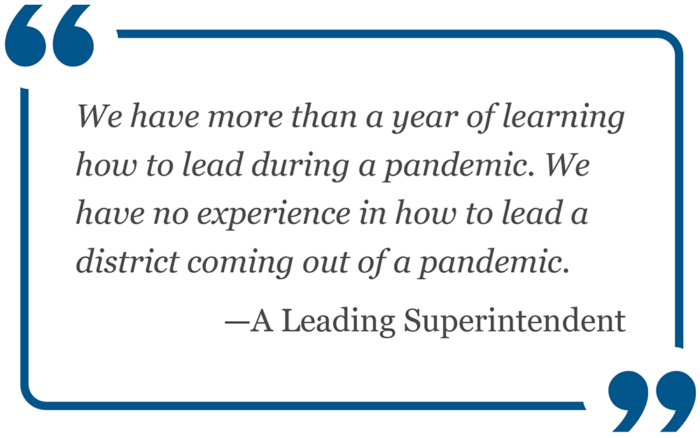
An incoming first-grader shyly enters her classroom for the first time; she’s never been inside a school before. Her classmate confidently sits down at a desk; she spent the last year in-person and knows the routines. Are they both on-par for the coming school year? A ninth-grader looks around at his high school class for the first time; he spent the last 15 months learning from home. Is he prepared for high school courses? Is he ready to sit in a classroom all day?
These types of challenges are coming our way. A leading superintendent warns, “We have more than a year of learning how to lead during a pandemic. We have no experience in how to lead a district coming out of a pandemic.” The year ahead will be unlike any other. Addressing new, unprecedented challenges will require flexibility and creativity from the field.
The COVID-19 pandemic, for all its devastation, has opened an opportunity for schools and districts to transition into a new era. While the past year highlighted existing systemic inequality in the U.S., it also challenged our assumptions about how and for whom schools work. Focus has shifted to an emphasis on equitable and accelerated student learning. The education field, like many others, needs to recognize and seize this moment as one to move forward and rethink the traditional.
The Biden Administration is providing new funds and flexibility to states and districts which, when used wisely, have the potential to catalyze innovation. These resources are short-term, presenting districts with a choice. They can spend heavily to overrun schools with trendy programs and short-term hires—nearly all of which will be gone in three years. Or, by combining the best of our practices from before the pandemic—those proven to have lasting impact—with the innovations created during the crisis, districts can transform schooling to be more effective and equitable.
We offer here a plan for the school year ahead, a dual pathway for accelerating learning in the short-term and creating sustainable change in the long-term. We want a new school year full of hope and excitement, while recognizing that even before the pandemic school was not working for many students. Our focus therefore cannot simply be on recovery, but on transformation.
Begin by learning the lessons of the recent past.
The pandemic required both educators and families to develop innovative ways of helping students learn. Teachers acquired new technology and presentation skills to incorporate into their in-school and online classrooms. School districts developed virtual methods of delivering and tailoring professional development to their teachers. Families became involved in their children’s schooling in new ways. While the solutions may have been developed in direct response to the pandemic, many lessons are emerging that have implications for the years ahead.
Collaboration and community building were particularly essential to many of the successes over the past year. The expansion of these relationships and the building of formalized structures to hear the voices of all community members will be just as key in transforming schools over the next year. By continuing to build and utilize these relationships, districts can work with their communities to identify the best practices to employ in the year ahead.
Districts should convene educators, students, and community members to identify promising strategies for accelerating student academic and social-emotional growth. These convenings can provide a vehicle for finding out from those on the ground what is making a difference for students, what is not, who’s being left out, and what nimble actions can drive progress forward.
Seize the summer by making learning joyful.
There will be pressure to use the summer exclusively to make up for any real or perceived learning loss. However, reverting to rote learning and drills will cause summer school to feel like a punishment for students who have fallen behind. Instead, districts can signal that summer school this year is not just about recovery, but an opportunity to reconnect students with each other and the school community.
To facilitate a unique summer experience, consider how students themselves would design summer learning. Blend together the foundational skills needed for recovery with the type of project-based, exploratory learning which engages students.
Open the school year by determining the starting points of students.
The key to getting the new school year off to a strong start is to build on student strengths. But teachers must know those strengths before they can build upon them. Teachers will need to listen to students in new ways when they come back to the classroom, gathering data on the ground-level to meet their mental, physical, and academic needs. To do so, schools must provide teachers with the support and structures which formalizes check-ins with students and allows them to gather the information needed to tailor their instructional strategies to the needs of individual students.
Focus the fall on personalizing both student and adult learning.
We know that students will be re-entering school with many different starting points—academically, socially, and emotionally. By drawing on what they learn from students at the start of the new school year, teachers now have the data they need to build on student strengths and personalize instruction in new ways. They are better able to connect content to students’ starting points.
As districts and schools personalize learning for students, they also personalize professional development for teachers. Districts can invest in teachers by using the one-time federal resources to develop their skills to actively engage students through personalized and project-based learning. By strengthening the instructional capacities of teachers, districts plan for accelerated learning in the coming year alongside a broader focus on long-term sustainability.
Recognize equity is core to your mission.
The pandemic impacted marginalized communities disproportionately, exacerbating pre-existing divisions and achievement gaps in schools. The new resources and momentum of the post-pandemic period offer an opportunity for districts to prioritize equity and transform their schools to ensure all students can succeed. As districts review and refine their policies and practices, they must use equity as a guide to move them forward.
Leverage STEM to advance learning and equity.
Engaging students in accelerated, post-pandemic learning and personalizing instruction to their individual needs requires a creative approach to curriculum. Rather than focusing on remedial courses or simply placing a coding class on the schedule, integrating STEM across the core subjects of the curriculum can ensure that all students have rigorous, content-rich learning opportunities. Promoting innovation in STEM learning is a critically-needed way to reduce disparities and increase equity.
In the Tracy Unified School District in California, leaders are making clear, “STEM isn’t what we do. It’s who we are.” The district’s PreK–12 Pathway is ensuring that all students have robust STEM learning opportunities. Moreover, STEM instruction starts before kindergarten and extends through high school. This kind of curricular and instructional innovation accelerates learning and equity on a multi-disciplinary basis.
Make December and January the time to recalibrate.
In a year unlike any other, districts must use this December to think flexibility and creatively about how schooling is going to look in the next half of the year. Schools will learn many lessons throughout the fall on responding to students’ post-pandemic learning needs. They can refocus their plans for the spring based on evidence of both student progress and continuing needs that the fall has made visible.
Schools should ask: How well are we engaging students? To what extent are we making school a place students want to be? What is the evidence we are effective at personalizing learning? The answers to these guide schools as they prepare for the second half of the year. This January is used to create a new launch for the rest of the school year—taking what’s learned in the fall to inform nimble actions needed during the balance of the school year.
Reflect on new ways to engage students and staff schools to accelerate learning.
By spring, districts and schools are ready to reflect on a year unlike any other. Schools ask: Have we moved the school forward as much as we need to? To answer, it is time to bring the school community together again to celebrate successes, identify improvements, and inform the shape of the next school year.
Together, schools and their communities examine their progress in helping students to learn; academically, socially, and emotionally. They ascertain what kind of new normal is the reality in their classrooms—for every new first-grader, every new ninth-grader, and all of their peers. These reflections are key data points, fundamental to determining the next steps for innovation.
The pathway laid out here guides schools in recasting and transforming how to make learning come alive for students. The pandemic has underscored both the existing inequities of the education system and the creativity and innovation the education field is capable of achieving. We know the way forward: learning and listening to our communities, accelerated and personalized learning, well-supported teachers, and rigorous instruction through content-rich integrated STEM. Now we need leaders to seize this moment and opportunity to transform how and for whom schools work.
